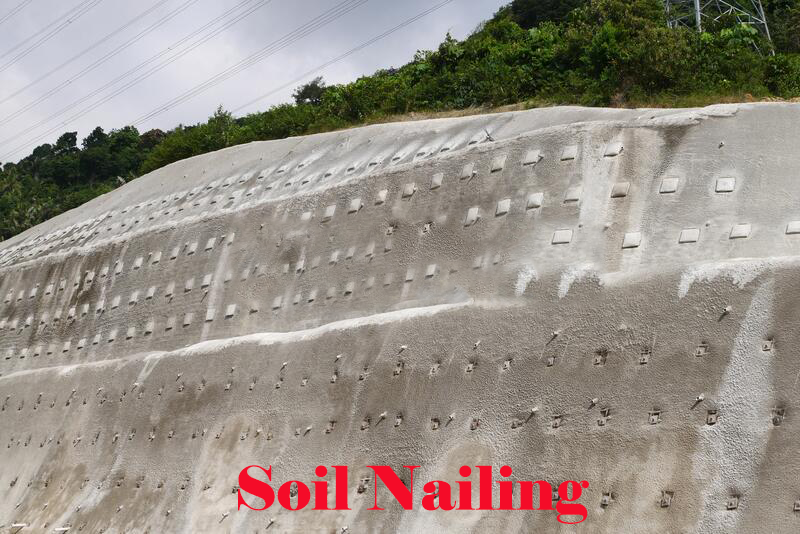Soil Nailing Installation Process
- Concrete Cost Estimator
- Concrete Continuous Footing
- Landscape Bidding and Estimating
- Construction Cost Estimating
- Concrete and steel cost estimation
- Construction Cost Estimate Breakdown
- Construction Estimating Worksheet
- Home Construction Cost Estimate
- Estimate Pricing Sheet
- Sheet for General Contractor
- Construction Cost Estimate
- Labor Materials Cost Estimator
- Masonry Estimating Sheet
- Sheet for Building Contractor
- Construction Schedule Bar chart
- General Cost Estimator Sheet
- General Construction Estimate
- Building and Road Estimating Sheet
- Detailed expense estimates
- Door and Window Takeoff Sheet
- General Construction Cost Estimating Sheet

Often during construction on river banks or mountains, civil engineers encounter the problem of slopes.
These slopes need to be reinforced or then can break and harm the construction. At times like this technique of Soil nailing saves the day.
This blog will discuss soil nailing and how is soil nailing done?
.What is Soil Nailing?
Soil nailing is a technique used to support the soil and make it more stable. It is used where the slopes have loose and weak soil, during excavations, and in many more places.
In Soil nail shoring, steel bars are drilled into the slope, and then covered with mesh. The soil nails and shotcrete hold the soil and provide support.
Also Read : How to make retaining soil stable with Compaction and Geogrid
Soil Nailing Technique
Let’s discuss how Soil nailing is done on natural or excavated slopes.
- First, reinforcement bars called nails are inserted at an inclination of between 10 to 20 degrees in the pre-drilled holes to support the soil.
- Then they are grouted with mortar.
- Then, shotcrete is sprayed on the excavation's face to reinforce the slope further.
Soil Nail Slope Stabilization: Types of Soil Nailing Techniques
There are various techniques used in Soil nailing.
1. Drilled and grouted soil nailing
Used for permanent stabilization of slopes. Nails are first drilled in the face of the excavation. Then shotcrete is sprayed on the face of the excavation. The nails' diameter is 100 to 200mm, with a spacing of 1.5m between the nails.
2. Driven soil nailing method
This method of Soil nailing is for the temporary stabilization of soil. The nails' diameter is between 19mm to 25mm, and the nail spacing is 1 to 1.2 m.
3. Self-drilling soil nailing method
In this Soil nailing method, hollow bars are used instead of nails. This method is faster than drilling nails and provides more corrosion resistance.
4. Jet-grouted soil nailing method
In this method, jets are used to drill holes in the soil. In this method, steel bars are used to support the soil.
This method of drilling holes provides good corrosion resistance.
5. Launched soil nail method
In this method, steel bars are inserted in the soil with the help of a compressed air mechanism. No pre-drilled holes are made. The steel bars are forced into the slope, as a result of which this method is fast but is difficult to the length of penetration.
Also Read : The Specific Gravity Test of Soil Particles
Advantages and Disadvantages of Soil Nailing
Here are some advantages and disadvantages of soil nailing.
Advantages of Soil Nailing
- Suitable for spaces with limited access, they are suitable for confined spaces.
- It has a less damaging effect on the environment.
- Installation is relatively quick and easy.
- There is a reduction in the amount of material and shoring used.
- They can be used on new constructions, temporary structures, or remodeling projects.
- There is no restriction on height.
Disadvantages of Soil Nailing
- It is not recommended to use them in areas with high water tables.
- There may be a need for very high soil nail density in soils with low shear strength.
- Not suitable for soils that are sensitive and expansive.
- There is a need for specialist contractors.
- At times there may arise a need for 3D modeling.
Conclusion
Soil nailing is indeed helpful in providing support on slopes and making construction manageable. Different methods of soil nailing are used in different circumstances. The size of the nail, the density of the nails, everything depends upon the nature of the slope and construction.
- Application of concrete calculator
- Roofing Calculator can streamline the roof estimating process
- House construction cost calculator
- Engineering column design excel spreadsheet
- Material Estimating Sheet with Excel
- Materials List and Cost Estimate Worksheet
- Concrete Slab Estimating Calculator Sheet
- Common types of foundations for buildings
- Online calculation of construction materials
- Estimating with Excel for the Small Contractor
- Concrete Beam Design Spreadsheet
- Virtual Construction Management app for construction
- Autodesk’s Project Skyscraper
- Reed Construction’s Reed Insight
- Manage your construction project documentation
- Costimator, the popular cost estimating software
- On Center Software for construction professionals
- Free Construction Estimating Software
- Plumbing Calc Pro
- Cost Estimate Worksheet
- HVAC Piping Quantity Takeoff Worksheet
- Construction Estimating Software Sheet
- Estimate Cost Templates
- Construction Punch List
- Construction cost estimating template consisting estimating basic
- Gantt Chart Template for Excel
- Download Civil Engineering Spreadsheets with Verification
- The Building Advisor Estimating and Budgeting Worksheet
- Spreadsheet for design of concrete bridge
- Construction Estimating Software Free









